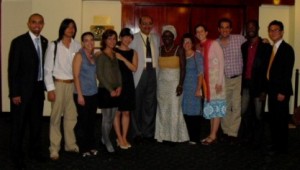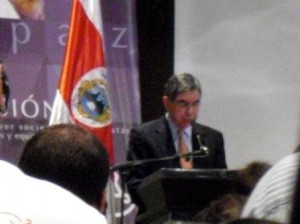Sunday
Featured StoriesReligions for Peace
By Anna Weinstein
When Oscar Arias, the president of Costa Rica and Nobel Peace Prize laureate, began his address with the life story of the Buddha, I felt a strange synchronicity with the Shambhala Congress taking place at the same time thousands of miles north.
The Global Youth Campaign of Religions for Peace kicked off its “Arms Down!” campaign for shared security in San Jose, Costa Rica from 7-9 November 2009. Religions for Peace is an interfaith organization that aims to capitalize on the strength and cohesion of existing religious communities to work toward common goals including stopping war, ending poverty, and protecting the environment. It convenes “World Conferences” every five years and collaborates with the Economic and Social Council of the United Nations, with UNESCO, and with UNICEF.
The “Arms Down!” campaign, launched in partnership with the Arias Foundation and the United Nations-mandated University for Peace, both based in Costa Rica, is a year-long petition campaign aimed at collecting 50 million signatures in support of three specific global goals:
1. To eliminate nuclear weapons,
2. To reduce and control small arms, including cluster munitions,
3. To redirect 10% of worldwide military expenditure toward the advancement of the United Nations’ Millennium Development Goals.
In fact, as we heard repeatedly over the course of the weekend, that 10% would be sufficient to fully meet all eight goals by the UN’s original deadline of 2015: eradicating extreme poverty and hunger; achieving universal primary education; promoting gender equality and empowerment of women; reducing child mortality; improving maternal health; combating HIV/AIDS, malaria, and other diseases; ensuring environmental sustainability; and developing a global partnership for development.

The UPeace delegation, with Vice-Rector and conference panelist Dr. Amr Abdalla in the centre and the author fifth from the right
And finally President Arias addresses the assembly, citing exhortations for peace from each major world religion. After relating the story of Siddhartha Gautama escaping his protected palace life and witnessing human suffering, President Arias stressed that “We are here today because, as young Siddhartha, you have understood the reality of pain, especially because of violence, and begun a spiritual path, and looked at the abyss of human suffering.” His was the first signature on the petition, which will eventually be used to recruit the support of governments and political leaders worldwide for the United Nations’ initiatives toward the three goals of the campaign. These initiatives include the Nuclear Non-Proliferation Treaty, the Mine Ban Treaty, and the Convention on Cluster Munitions, none of which have yet been universally ratified by UN member states.
I had the good fortune to attend the conference as an observer on behalf of the University for Peace, with about ten of my classmates as well as several professors. Along with representatives and youth leaders from worldwide religious organizations from all faiths, we attended skill-building workshops on topics like successful lobbying, engaging the media, and working with local politicians, observed panel discussions with academic, political, and religious activists on each of the campaign’s three goals, and participated in regional working groups to discuss the logistics of reaching the target goal of fifty million signatures within one year.
The Global Youth Campaign plans to reconvene in autumn 2010. As the conference follow-up report proclaims, “We will bring about a more secure future. Instead of raising arms up to hurt our fellow humans, we will tell our leaders to trust in the promise of shared security. We will tell them: Arms Down! “
Click here for more information.
_________________________________
Anna grew up on the Shambhala nomad circuit and worked as Centre Services Coordinator for Shambhala Europe for the past three years. She is currently working toward an M.A. in Media, Peace and Conflict Studies at the United Nations-mandated University for Peace near San Jose, Costa Rica. She misses her dog and hopes to have a job someday.







Dec 23, 2009
Reply
Dear Anna,
I was delighted to see this fascinating article by you on Shambhala Times and to know that you were attending the Global Youth Campaign conference, along with your classmates, as an observer on behalf of the University of Peace. It is a marvellous institution and an important part of our evolving world culture. I share your tingling when you heard President Arias begin his talk by referring to the life of the buddha. It reminds me of a message from the former UN Secretary General, Kofi Annan, on Vesak Day a few years ago when he said:
“In this time of global uncertainty, the Buddha’s vision of peace and of humanity’s highest potentials may be more relevant than ever before.”
With the warmest of wishes, Richard